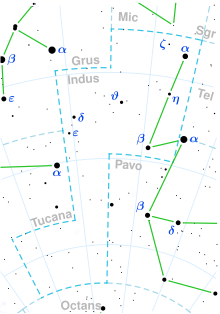Alpha Indi
| Observation data Epoch J2000 Equinox J2000 | |
|---|---|
| Constellation | Indus |
| Right ascension | 20h 37m 34.032s[1] |
| Declination | –47° 17′ 29.4052″[1] |
| Apparent magnitude (V) | 3.11[2] |
| Astrometry | |
| Radial velocity (Rv) | −1.3[3] km/s |
| Proper motion (μ) | RA: +50.922 mas/yr[1] Dec.: +66.026 mas/yr[1] |
| Parallax (π) | 32.8989 ± 0.2225 mas[1] |
| Distance | 99.1 ± 0.7 ly (30.4 ± 0.2 pc)[1] |
| Absolute magnitude (MV) | 0.65[4] |
| Characteristics | |
| Evolutionary stage | between subgiant and giant star |
| Spectral type | K0 III–IV[5] |
| U−B color index | +0.79[2] |
| B−V color index | +1.00[2] |
| Details[6] | |
| Mass | 1.879±0.13 M☉ |
| Radius | 9.706±0.294 R☉ |
| Luminosity | 59[7] L☉ |
| Surface gravity (log g) | 2.96±0.1 cgs |
| Temperature | 4896±34 K |
| Metallicity [Fe/H] | −0.05±0.03 dex |
| Age | 1.572±0.273 Gyr |
| Other designations | |
| Database references | |
| SIMBAD | data |
Alpha Indi (α Ind, α Indi) is the brightest star in the southern constellation Indus. Parallax measurements imply that it is located about 100 light years from Earth.[1] It is visible to the naked eye at an apparent visual magnitude of 3.22.[2] Considering its distance and apparent magnitude, its absolute magnitude is equal to 0.65.[4]
Characteristics[edit]
The stellar classification of Alpha Indi is K0 III-IV,[5] meaning that it has exhausted the hydrogen at its core and evolved away from the main sequence, being now halfway between a subgiant and a giant star. It is 59 times more luminous than the Sun,[7] has 88% more mass, and is estimated to be 1.6 billion years old.[6] At this age, it has expanded to about 10 times the size of the Sun.[6] The effective temperature of its photosphere is 4,900 K,[6] giving it the characteristic orange hue of a K-type star.[9] It may have two nearby M-type companion stars, which are located at least 2,000 AU from the primary.[10]
Nomenclature[edit]
Alpha Indi is the star's Bayer designation.[8] In China, this star is called Pe Sze where it also was known as the Persian, a title from the Jesuit missionaries.[11] The term Pe Sze is from the name of asterism 波斯 (Bō Sī, English: Persia). In Chinese astronomy, consequently, α Indi itself is known as 波斯二 (Bō Sī èr, English: the Second Star of Persia)[12]
References[edit]
- ^ a b c d e f Vallenari, A.; et al. (Gaia collaboration) (2023). "Gaia Data Release 3. Summary of the content and survey properties". Astronomy and Astrophysics. 674: A1. arXiv:2208.00211. Bibcode:2023A&A...674A...1G. doi:10.1051/0004-6361/202243940. S2CID 244398875. Gaia DR3 record for this source at VizieR.
- ^ a b c d Johnson, H. L.; et al. (1966), "UBVRIJKL photometry of the bright stars", Communications of the Lunar and Planetary Laboratory, 4 (99): 99, Bibcode:1966CoLPL...4...99J
- ^ Evans, D. S. (June 20–24, 1966), "The revision of the general catalogue of radial velocities", in Batten, Alan Henry; Heard, John Frederick (eds.), Determination of Radial Velocities and their Applications, Proceedings from IAU Symposium no. 30, vol. 30, University of Toronto: International Astronomical Union, p. 57, Bibcode:1967IAUS...30...57E
- ^ a b Thorén, P.; Edvardsson, B.; Gustafsson, B. (October 2004), "Subgiants as probes of galactic chemical evolution", Astronomy and Astrophysics, 425: 187–206, arXiv:astro-ph/0407260, Bibcode:2004A&A...425..187T, doi:10.1051/0004-6361:20040421, S2CID 2116895
- ^ a b Gray, R. O.; et al. (July 2006), "Contributions to the Nearby Stars (NStars) Project: Spectroscopy of Stars Earlier than M0 within 40 parsecs: The Northern Sample I", The Astronomical Journal, 132 (1): 161–170, arXiv:astro-ph/0603770, Bibcode:2006AJ....132..161G, doi:10.1086/504637, S2CID 119476992
- ^ a b c d Gomes da Silva, J.; Santos, N. C.; Adibekyan, V.; Sousa, S. G.; Campante, T. L.; Figueira, P.; Bossini, D.; Delgado-Mena, E.; Monteiro, M. J. P. F. G.; de Laverny, P.; Recio-Blanco, A.; Lovis, C. (2021-02-01). "Stellar chromospheric activity of 1674 FGK stars from the AMBRE-HARPS sample. I. A catalogue of homogeneous chromospheric activity". Astronomy and Astrophysics. 646: A77. doi:10.1051/0004-6361/202039765. ISSN 0004-6361. Alpha Indi's database entry at VizieR.
- ^ a b McDonald, I.; Zijlstra, A. A.; Boyer, M. L. (2012-11-01). "Fundamental parameters and infrared excesses of Hipparcos stars". Monthly Notices of the Royal Astronomical Society. 427: 343–357. doi:10.1111/j.1365-2966.2012.21873.x. ISSN 0035-8711. Alpha Indi's database entry at VizieR.
- ^ a b "alf Ind -- Star in double system", SIMBAD, Centre de Données astronomiques de Strasbourg, retrieved 2011-12-12
- ^ "The Colour of Stars", Australia Telescope, Outreach and Education, Commonwealth Scientific and Industrial Research Organisation, December 21, 2004, archived from the original on March 18, 2012, retrieved 2012-01-16
- ^ Kaler, James B., "THE PERSIAN (Alpha Indi)", Stars, University of Illinois, retrieved 2011-12-23
- ^ Star Name - R.H.Allen p. 246
- ^ (in Chinese) AEEA (Activities of Exhibition and Education in Astronomy) 天文教育資訊網 2006 年 7 月 30 日)

